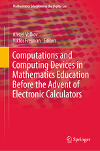- About MAA
- Membership
- MAA Publications
- Periodicals
- Blogs
- MAA Book Series
- MAA Press (an imprint of the AMS)
- MAA Notes
- MAA Reviews
- Mathematical Communication
- Information for Libraries
- Author Resources
- Advertise with MAA
- Meetings
- Competitions
- Programs
- Communities
- MAA Sections
- SIGMAA
- MAA Connect
- Students
- MAA Awards
- Awards Booklets
- Writing Awards
- Teaching Awards
- Service Awards
- Research Awards
- Lecture Awards
- Putnam Competition Individual and Team Winners
- D. E. Shaw Group AMC 8 Awards & Certificates
- Maryam Mirzakhani AMC 10 A Awards & Certificates
- Two Sigma AMC 10 B Awards & Certificates
- Jane Street AMC 12 A Awards & Certificates
- Akamai AMC 12 B Awards & Certificates
- High School Teachers
- News
You are here
Computations and Computing Devices in Mathematics Education Before the Advent of Electronic Calculators

Publisher:
Springer
Publication Date:
2019
Number of Pages:
471
Format:
Hardcover
Series:
Mathematics Education in the Digital Era
Price:
139
ISBN:
978-3319733944
[Reviewed by , on ]
Peggy Kidwell
04/6/2019
This volume is part of a series on “mathematics education in the digital era” that seeks to explore connections between such education and the development of inexpensive electronic calculators and computers. Stepping back from this theme, the editors of this volume have drawn together a diverse array of articles on computations and computing in mathematics education before the ready availability of electronic devices. The topics selected are breathtaking in scope – time periods range from antiquity to the twentieth century and locations of learning include Asia, Russia, Europe, and the United States.
For much of this history, the authors rely on a careful reading of manuscripts and published documents. They describe in detail algorithms presented for doing arithmetic. Some descriptions include instruments like counting rods and various forms of the abacus. These sections bring out differences in practice between India, China, Korea, and Japan. Incidentally, they offer useful current references on the history of such objects.
Explaining procedures as stated in texts provides useful insights. At the same time, it provokes at least this reader to ask just how well such written documents reflect the manner in which learners actually came to know a mathematical topic that also often was taught orally. More generally, the book – even in the chapter on the history of adding and calculating machines – does not mention instruction provided to those who were taught to do arithmetic operations as part of their work as (human) computers. This is an area of late nineteenth and early twentieth-century mathematics education that merits attention.
The strength of the volume lies in its summaries of rich stories. For example, Alexander Karp provides a fascinating summary the history national politics lying behind arithmetic instruction in Russia, as seen from looking at textbooks. Looking further west, Gert Schubring gives a systematic and useful outline of national educational policies relating to the use of logarithmic table and of slide rules in France, England, the Netherlands, and Germany. Final articles touch on more recent classroom practice.
How this volume will be received by those learning and teaching undergraduate mathematics and mathematics education I do not know. Certainly selection of one or two chapters from it could serve as a useful starting point for a class lecture, a history of mathematics paper, or a senior thesis. More generally, the volume offers a tantalizing glimpse into the history of education in calculation up to about 1970.
Peggy Aldrich Kidwell is Curator of Mathematics at the Smithsonian’s National Museum of American History. With Amy Ackerberg-Hastings and David Lindsay Roberts, she is coauthor of Tools of American Mathematics Teaching: 1800-2000 (Johns Hopkins University Press, 2008). She can be reached at kidwellp@si.edu.
See the publisher's table of contents.
- Log in to post comments




